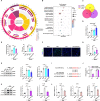Observing Extracellular Vesicles Originating from Endothelial Cells in Vivo Demonstrates Improved Astrocyte Function Following Ischemic Stroke via Aggregation-Induced Emission Luminogens
- PMID: 37535897
- PMCID: PMC10448755
- DOI: 10.1021/acsnano.3c05309
Observing Extracellular Vesicles Originating from Endothelial Cells in Vivo Demonstrates Improved Astrocyte Function Following Ischemic Stroke via Aggregation-Induced Emission Luminogens
Abstract
Extracellular vesicles (EVs) obtained from endothelial cells (ECs) have significant therapeutic potential in the clinical management of individuals with ischemic stroke (IS) because they effectively treat ischemic stroke in animal models. However, because molecular probes with both high labeling efficiency and tracer stability are lacking, monitoring the actions of EC-EVs in the brain remains difficult. The specific intracellular targets in the brain that EC-EVs act on to produce their protective effects are still unknown, greatly impeding their use in clinical settings. For this research, we created a probe that possessed aggregation-induced emission (AIE) traits (namely, TTCP), enabling the effective labeling of EC-EVs while preserving their physiological properties. In vitro, TTCP simultaneously had a higher EC-EV labeling efficiency and better tracer stability than the commercial EV tags PKH-67 and DiI. In vivo, TTCP precisely tracked the actions of EC-EVs in a mouse IS model without influencing their protective effects. Furthermore, through the utilization of TTCP, it was determined that astrocytes were the specific cells affected by EC-EVs and that EC-EVs exhibited a safeguarding impact on astrocytes following cerebral ischemia-reperfusion (I/R) injury. These protective effects encompassed the reduction of the inflammatory reaction and apoptosis as well as the enhancement of cell proliferation. Further analysis showed that miRNA-155-5p carried by EC-EVs is responsible for these protective effects via regulation of the c-Fos/AP-1 pathway; this information provided a strategy for IS therapy. In conclusion, TTCP has a high EC-EV labeling efficiency and favorable in vivo tracer stability during IS therapy. Moreover, EC-EVs are absorbed by astrocytes during cerebral I/R injury and promote the restoration of neurological function through the regulation of the c-Fos/AP-1 signaling pathway.
Keywords: aggregation-induced emission; astrocytes; extracellular vesicles; fluorescence imaging; human umbilical vein endothelial cells; ischemic stroke.
Conflict of interest statement
The authors declare no competing financial interest.
Figures









Similar articles
-
Mesenchymal stem cell-derived extracellular vesicles attenuate tPA-induced blood-brain barrier disruption in murine ischemic stroke models.Acta Biomater. 2022 Dec;154:424-442. doi: 10.1016/j.actbio.2022.10.022. Epub 2022 Oct 29. Acta Biomater. 2022. PMID: 36367475
-
In Vivo Tracking of Mesenchymal Stem Cell-Derived Extracellular Vesicles Improving Mitochondrial Function in Renal Ischemia-Reperfusion Injury.ACS Nano. 2020 Apr 28;14(4):4014-4026. doi: 10.1021/acsnano.9b08207. Epub 2020 Apr 3. ACS Nano. 2020. PMID: 32212674
-
In Vivo Real-Time Imaging of Extracellular Vesicles in Liver Regeneration via Aggregation-Induced Emission Luminogens.ACS Nano. 2019 Mar 26;13(3):3522-3533. doi: 10.1021/acsnano.8b09776. Epub 2019 Mar 12. ACS Nano. 2019. PMID: 30844245
-
Extracellular Vesicles as Mediators of Cellular Crosstalk Between Immune System and Kidney Graft.Front Immunol. 2020 Feb 27;11:74. doi: 10.3389/fimmu.2020.00074. eCollection 2020. Front Immunol. 2020. PMID: 32180768 Free PMC article. Review.
-
The role of small extracellular vesicles in cerebral and myocardial ischemia-Molecular signals, treatment targets, and future clinical translation.Stem Cells. 2021 Apr;39(4):403-413. doi: 10.1002/stem.3329. Epub 2021 Jan 12. Stem Cells. 2021. PMID: 33432732 Review.
Cited by
-
Roles and Potential Mechanisms of Endothelial Cell-Derived Extracellular Vesicles in Ischemic Stroke.Transl Stroke Res. 2025 Feb 7. doi: 10.1007/s12975-025-01334-4. Online ahead of print. Transl Stroke Res. 2025. PMID: 39918683 Review.
-
Revolutionizing Ischemic Stroke Diagnosis and Treatment: The Promising Role of Neurovascular Unit-Derived Extracellular Vesicles.Biomolecules. 2024 Mar 20;14(3):378. doi: 10.3390/biom14030378. Biomolecules. 2024. PMID: 38540796 Free PMC article. Review.
-
Development and validation of a predictive nomogram for vascular crises in oral and maxillofacial cancer patients undergoing free flap surgery.PLoS One. 2024 Dec 4;19(12):e0314676. doi: 10.1371/journal.pone.0314676. eCollection 2024. PLoS One. 2024. PMID: 39630781 Free PMC article.
-
Extracellular Vesicles for Clinical Diagnostics: From Bulk Measurements to Single-Vesicle Analysis.ACS Nano. 2025 Aug 12;19(31):28021-28109. doi: 10.1021/acsnano.5c00706. Epub 2025 Jul 28. ACS Nano. 2025. PMID: 40720603 Free PMC article. Review.
-
Targeting capabilities of engineered extracellular vesicles for the treatment of neurological diseases.Neural Regen Res. 2025 Nov 1;20(11):3076-3094. doi: 10.4103/NRR.NRR-D-24-00462. Epub 2024 Oct 22. Neural Regen Res. 2025. PMID: 39435635 Free PMC article.
References
-
- Global, Regional, and National Incidence, Prevalence, and Years Lived with Disability for 301 Acute and Chronic Diseases and Injuries in 188 Countries, 1990–2013: A Systematic Analysis for the Global Burden of Disease Study 2013. Lancet (London, England) 2015, 386 (9995), 743–800. 10.1016/S0140-6736(15)60692-4. - DOI - PMC - PubMed
Publication types
MeSH terms
Substances
LinkOut - more resources
Full Text Sources
Medical

